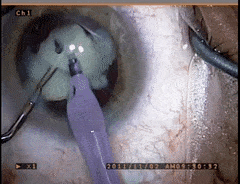Clear Vision for a Bright Future: Observing Cataract Awareness Month
- Peter Charron
- Jun 2, 2023
- 2 min read
Updated: Jul 2, 2025
Welcome to June, the month dedicated to raising awareness about one of the most common eye conditions affecting millions of people worldwide—cataracts.
As an optometrist, it is my duty to shed light on this condition, its various types, preventive measures, and the crucial role we play in diagnosing and treating cataracts.
Understanding Cataracts:
Imagine looking through a foggy window that blurs your vision and dims the world around you. That's similar to what people with cataracts experience.
Cataracts refer to the clouding of the eye's natural lens, which lies behind the iris and pupil. This clouding gradually interferes with the passage of light to the retina, leading to vision impairment.
Types of Cataracts:
Cataracts can occur in different parts of the lens and develop for various reasons. Some common types include:
Age-related Cataracts:
These are the most prevalent type and occur due to natural aging processes. Over time, protein in the lens clumps together, causing clouding and vision decline.
Congenital Cataracts:
These are present at birth or develop during infancy. They may occur due to genetic disorders, infections during pregnancy, or trauma.
Traumatic Cataracts:
These result from an injury to the eye, causing clouding of the lens. They can occur immediately after the trauma or even years later.
Secondary Cataracts:
Certain medical conditions such as diabetes, long-term use of corticosteroids, or exposure to radiation can lead to the development of secondary cataracts.
Prevention is Better than Cure:
While age-related cataracts cannot be entirely prevented, there are steps you can take to reduce the risk and delay their onset. Here are some preventive measures:
Quit smoking or avoid secondhand smoke, as smoking has been linked to an increased risk of developing cataracts.
Maintain a healthy lifestyle that includes a balanced diet rich in antioxidants, vitamins, and minerals. Include foods like leafy greens, citrus fruits, and colorful vegetables.
Manage any underlying medical conditions such as diabetes or hypertension, as they can contribute to cataract formation.
Regularly visit your optometrist for comprehensive eye exams. They can identify early signs of cataracts and monitor their progression.
The Role of Optometrists:
Optometrists are primary eye care providers with specialized knowledge and expertise in diagnosing and managing various eye conditions, including cataracts. Here's how we contribute to your eye health:
Comprehensive Eye Exams: During an eye exam, your optometrist will thoroughly assess your visual acuity, measure your eye pressure, and examine the structures of your eyes. This includes evaluating the clarity of your lenses and detecting any signs of cataracts.
Early Diagnosis: Optometrists can identify cataracts at their early stages, even before they start causing significant vision problems. Early detection allows for timely intervention and management.
Treatment and Referral: If cataracts are affecting your vision and quality of life, your optometrist will discuss treatment options. In the early stages, corrective lenses, such as glasses or contact lenses, may help improve your vision. However, if cataracts progress and significantly impair your daily activities, a referral to an ophthalmologist for cataract surgery may be necessary.

Post-operative Care: Optometrists play a crucial role in post-operative care following cataract surgery. They monitor your healing process, prescribe any necessary medications, and ensure your vision





Comments